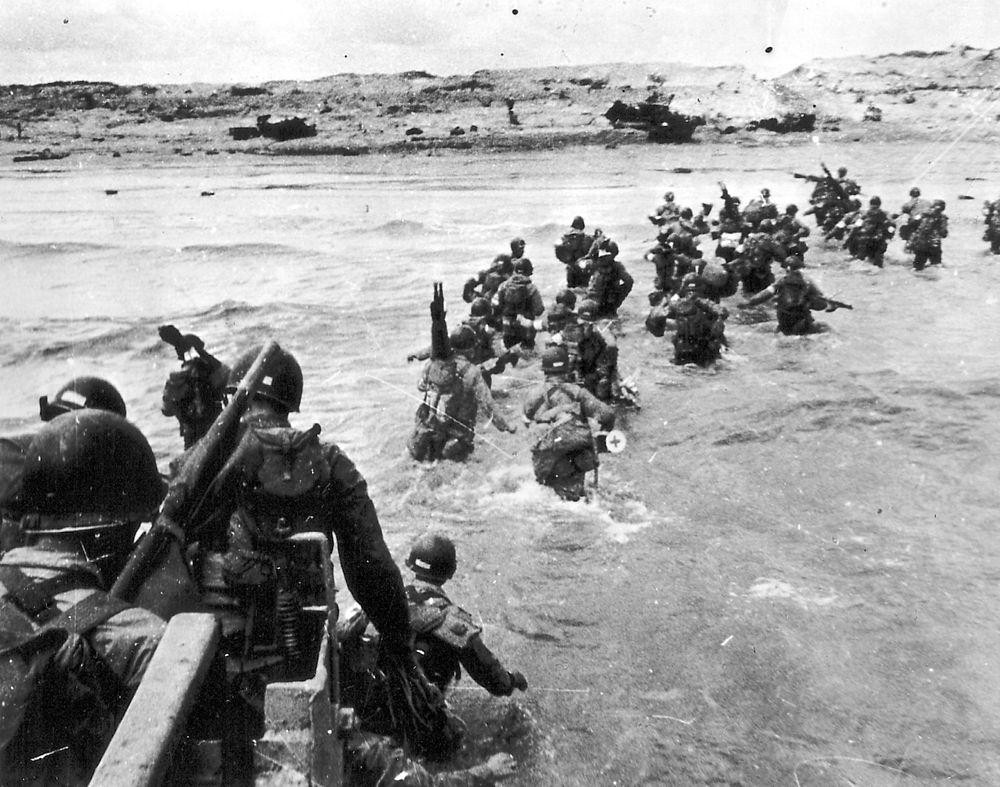
D-Day Assault: Beach Landings--Utah

Figure 1.--The Utah landings were conducted by the 4th Division. The landings began off course. The men had to wade ahore. Many had longer distance than the men here. The differemve from Omaha was that they were mot subjected to withering shore fire. This appears to be the first wave. We are not sure what the vehicles on the beach were.
|
|
Utah was the second American beach. A minute by minute account at Utah reads, "6:25 am. Four hundred yards from Utah Bach, Captain George Mabry, just behind the first wave, is looking at the shore. None of it looks as it did in the reconnaissance photos. Where are the high Varreville dunes? Where is the windmill? Something is seriously wrong ... The US landing craft are now only about 100 yards from the shores of Omaha and Utah Beaches." [Mayo] And in fact, the American 4th Infantry Division landed at the wrong location. It fortutiously proved to be lightly defended. The intended beach site was much more heavily defended. D-Day summaries commonly report on the light casulaties. Less commonly do they mention the second day when the Germans counter attacked and there were substantial casualties. The commanding officer, Beig. Gen Thodore Roosevelt, Jr. was President Theodore Rooevelt's eldest on. On realizing that he had landed on the wrong beach. he famously said, "We’ll start the war from right here!" Utah was about 3 miles long. It was the westernmost of the five D-Day landing beaches. It was located between the villages of Pouppeville and La Madeleine which became the right flank anchor of the Allied beachhead. Most of the D-Day tanks made it ashore on Utah, helping to beak out of the beach head. Many of the defending German units at Utah were Ost Battalions that had been pounded by naval artillery. The Ost battalions were non-Germans, but recruited in Soviet POW camps (where they were starving) or drafted into the Wehrmacht. They readily surrendered or ran. Most of the casulties on Utah were from German artillery. The Americans on Utah quickly moved inland and the paratroopers dropped earlier made it impossible for the Germans to bring up reinforcemets to oppose the landings. Utah was largely secured by 8:30 AM. By noon the beach landing forces moving inland were making contact with paratroopers from the 101st Airborne Division. By the end of the day, the 4th Infantry Division had pushed 6 miles inland within a mile of the 82nd Airborne Division’s perimeter. The Americans on Utah were the western flank of the Allied landing force. Thus they were dangerously isolated, unlike the other four beaches. There was a substantial gap created by the Douve River. Thus a critical objective was to link up with the hard-won Omaha bidgehead. The key to the link up was Carentan which was also vital in contoling the Cotentin Peninsula with the port of Cherbourg. There were 6 days of bitter fighting before the town was was liberated and the the junction between Utah and Omaha was secured.
Sources
Mayo, Jonathan. D-Day: Minute by Minute (2014), 288p.
CIH -- WW II

Navigate the CIH World War II Section:
[Return to Main D-Day invasion landings page ]
[Return to Main D-Day invasion page ]
[Return to Main D-Day page ]
[Return to Main Canadian World War II page]
[Biographies]
[Campaigns]
[Children]
[Countries]
[Deciding factors]
[Diplomacy]
[Geo-political crisis]
[Economics]
[Home front]
[Intelligence]
[POWs]
[Resistance]
[Race]
[Refugees]
[Technology]
[Bibliographies]
[Contributions]
[FAQs]
[Images]
[Links]
[Registration]
[Tools]
[Return to Main World War II page]
[Return to Main war essay page]
Created: 9:21 AM 6/13/2019
Last updated: 9:21 AM 6/13/2019



